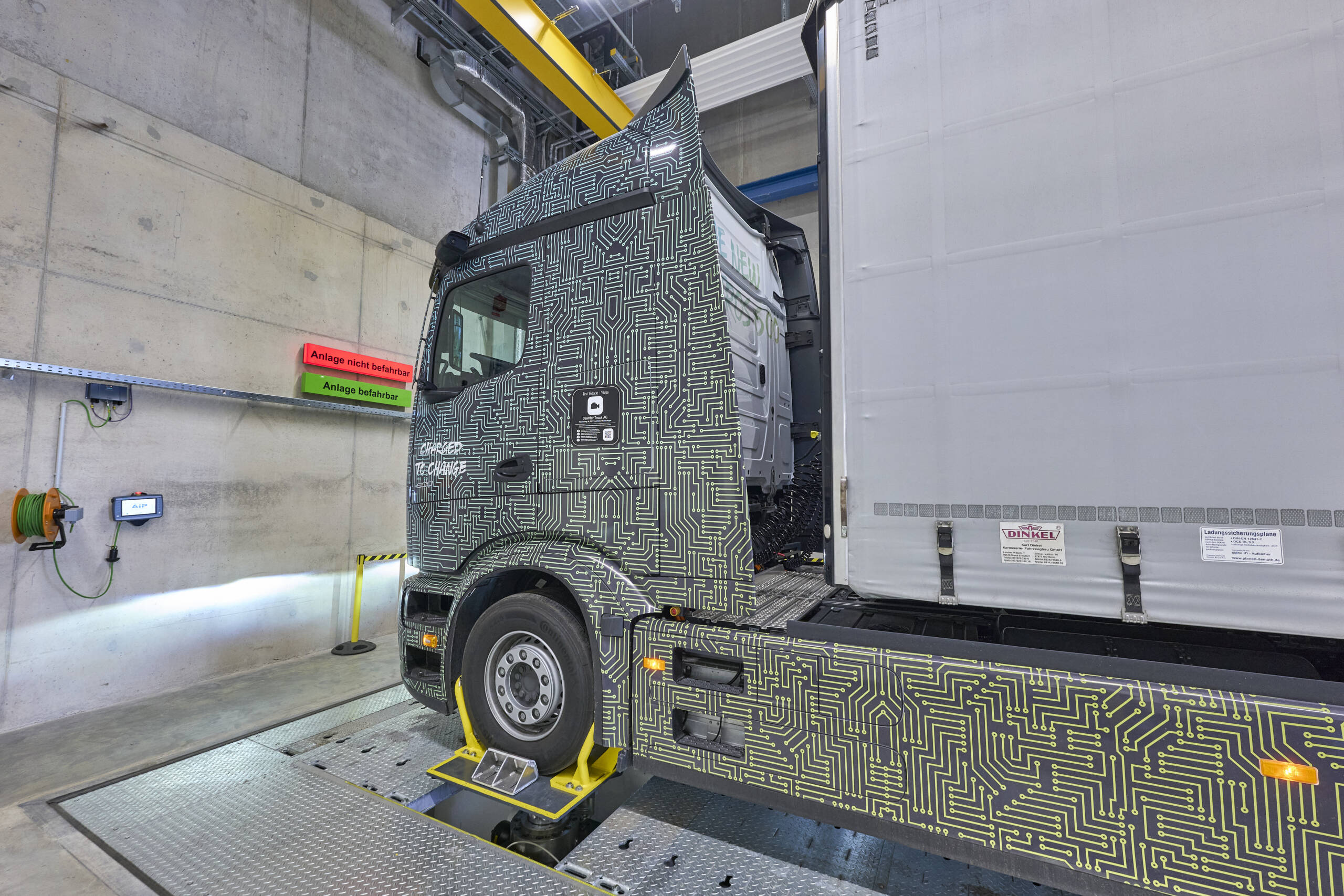At the EVZ, such testing and evaluation processes are part of everyday work – irrespective of the drive type of the vehicles. Activities center, however, increasingly around specialization on test procedures relating to battery-electric and hydrogen-based truck drive systems – and these, in turn, are currently focusing on the battery-electric Mercedes‑Benz eActros 600, which is being prepared in leaps and bounds for series production.

Test rig building 220 at the EVZ premises in Wörth houses the Multi Piston Bench, a new development that is probably unique in the world, for analyzing the vibration behavior of vehicles with regard to driver comfort and safety. Another installation at the site is one of Europe’s most powerful Climatic Test Chambers in which testing can be performed at extremely cold and extremely hot temperatures. Both test facilities were designed from the outset with trucks with alternative drives such as the Mercedes‑Benz eActros 600 in mind.
Roadway simulation and vehicle behavior in the Multi Piston Bench
The Multi Piston Bench performs simulations of the vibrations caused by different roadway surfaces. For this purpose, a collection of different roadway surfaces from real life are generated and simulated on the basis of data from actual surveys entered into the system; the simulations range from highway itineraries, rural roads and potholed roadways through to routes consisting completely of poor roads. The generation of vibrations in the vehicle is achieved in a vertical and longitudinal direction using excitation signals with a defined amplitude and frequency.
The developers’ top priority is to use the Multi Piston Bench to obtain validated measuring results and reproducible vibration and resonance analyses of complete vehicles. Irrespective of the drive variant, the vibration and acceleration behavior of individual vehicle components and assemblies can be examined and assessed. In this context, the behavior of the chassis and body parts and the effect on traveling comfort is measured and evaluated at differing excitation frequencies. Testing scenarios in the Multi Piston Bench not only include examining the stable installation of bearings and shock absorbers and the effect of their vibration behavior on other vehicle components but also identifying narrow places where abrasion can occur, such as cable and pipe ducts.
Depending on the scope, the examination of the vibration and resonance behavior of the complete vehicle or individual assemblies can take between eight and 14 days.

Structure and function of the Multi Piston Bench in Wörth
With its dimensions and its unparalleled testing possibilities, the Multi Piston Bench is unique in terms of its high performance capabilities. It forms a combination of ten hydraulic cylinders installed longitudinally and ten vertically on an innovative vibration foundation that causes the vehicle clamped in position to vibrate in a targeted manner. One cylinder acting vertically and one longitudinally have been installed for each wheel, and in the case of twin tires, for each pair of wheels.
The vibration foundation bears on a concrete foundation and before each vibration test takes place it is raised using air springs and decoupled from the environment. This prevents the vibrations and oscillations generated during the test procedure from being transmitted to the test rig building. The Multi Piston Bench is driven by a central hydraulic unit consisting of eight pumps with an oil pressure of 280 bars. Each cylinder has a load limit of eight tons.
The cylinders can be controlled individually. This means that the Multi Piston Bench can be used to measure, examine and analyze the vibration behavior of complete vehicles with up to five axles and a maximum total length of 20 meters. The track width is variable – it can be set to any value between 1.77 meters and 2.06 meters. In this facility, it is possible to test vehicles with semitrailers or trailers with a width of up to 2.50 meters, a maximum height of 5.30 meters, a maximum wheel load of eight tons and a maximum combined weight of up to 60 tons.
Hot and cold: the high-performance Climatic Test Chamber
The high performance Climatic Test Chamber at the EVZ in Wörth was designed from the outset for use also with electric and hydrogen-powered vehicles. The benefit: In contrast to real-life testing on location, for example in Finland or Spain, the Climatic Test Chamber makes it possible to flexibly reproduce the simulated climate conditions under comparable environmental conditions throughout the year.
The Climatic Test Chamber operates in the temperature range from -40 °C to +70 °C. In addition to temperature is also has a humidity control that makes it possible to set different humidity levels of up to 100 percent, as required, within the limits of physics. The temperature change coefficient for temperature settings and humidity determinations is 1.0 Kelvin or one degree Celsius per minute; the desired values can be specified with a high level of precision. This means that technical innovations as well as mechanical, electric and comfort functions, such as the air-conditioning, for conventional and alternative drives alike can be tested under climatic conditions ranging from arctic to subtropical.
There is space for two semitrailer tractors in the Climatic Test Chamber. In this chamber, extensive tests are performed on how diverse systems behave under changing temperatures and humidity conditions. Optimization of the cold start behavior of internal-combustion and electric vehicles is an important component in this regard. With e-trucks, the most important aspects of testing are battery management and the battery’s charge (SoC).
The driver’s cab air-conditioning is tested in the Climatic Test Chamber, as is the state and the efficiency of the insulation against cold and heat used in the vehicles. In addition, functional testing of mechanical and electric components, such as the steering, tipping cylinders and front hood, is performed under different climatic conditions. Similarly, optional truck equipment specifically for use in Nordic countries undergoes procedures to test proper functioning in arctic cold.










